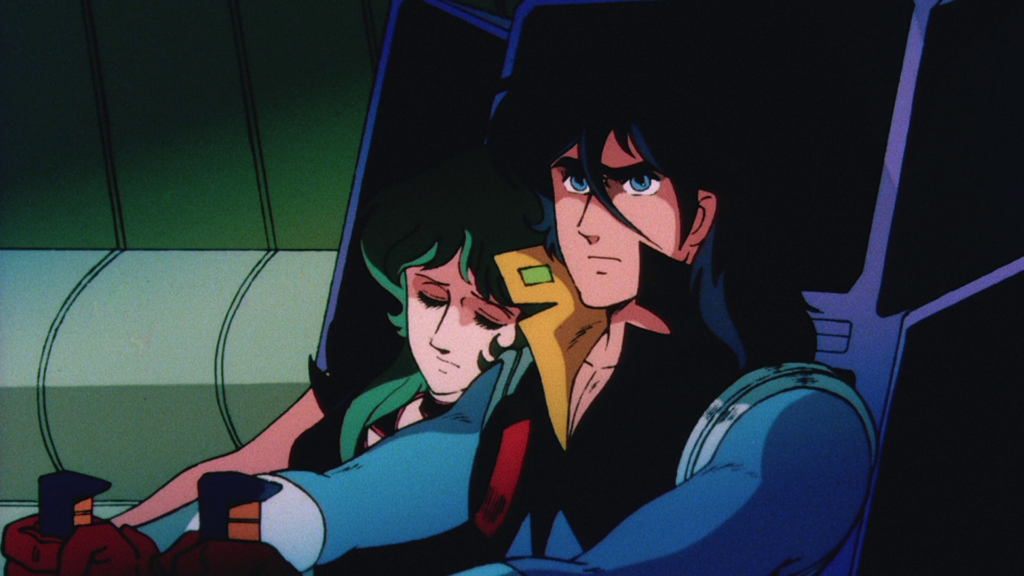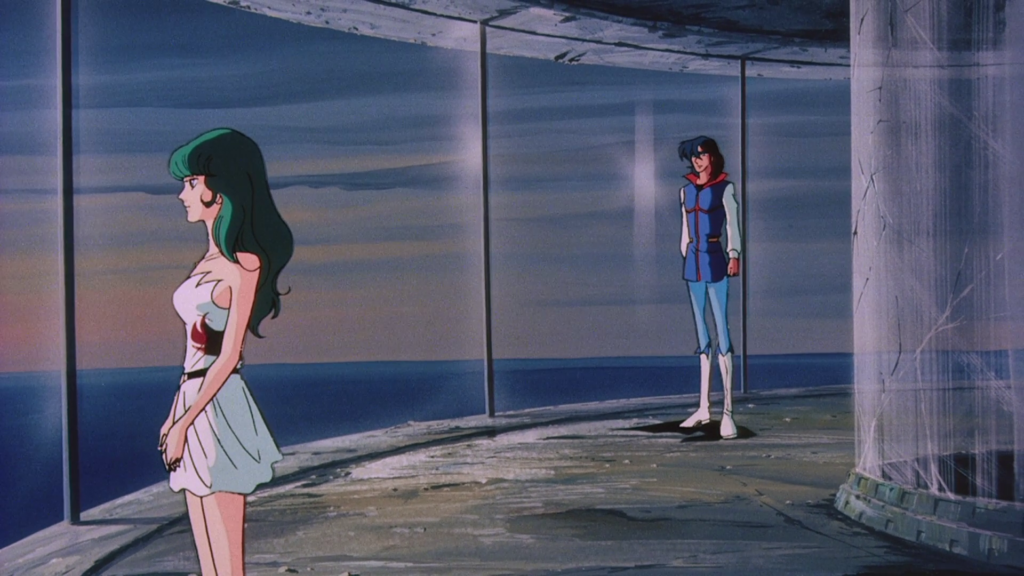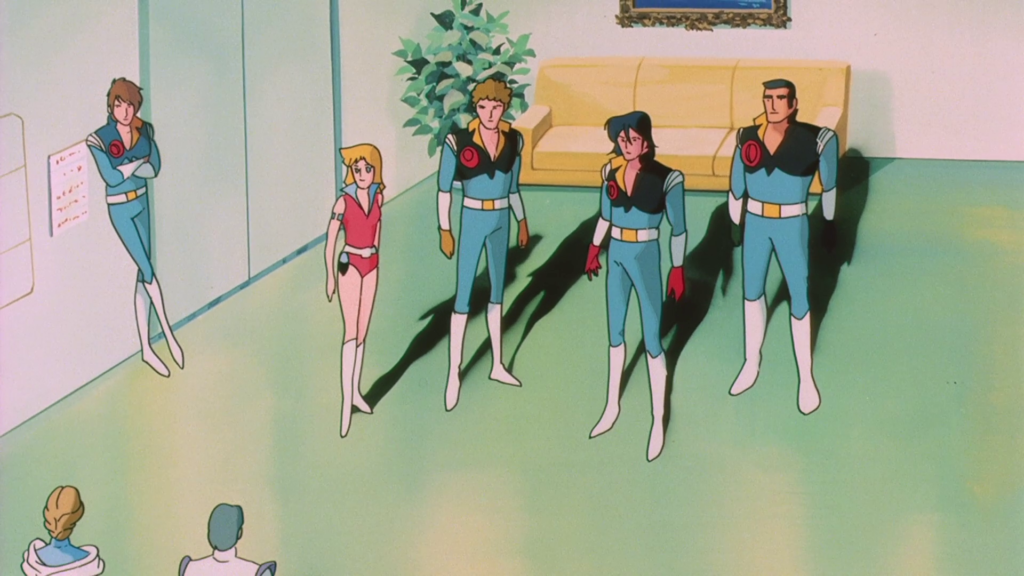DIRECTED BY: HISAYUKI TORIUMI/1981
BLU-RAY STREET DATE: MAY 1, 2018/DISCOTEK MEDIA

In the year 1980, the super robot anime Space Warrior Baldios exploded onto Japanese airwaves. And by “exploded” I mean “bombed”, in a big way. The series was cancelled before it could finish its 39 episode run, with 34 episodes completed and only 31 aired. Despite this poor reception, the melodrama and romance between the series’s leads helped develop some measure of a fan following, whose requests for a better conclusion to the series resulted in today’s subject.
Baldios: The Movie comes to us on Blu-Ray courtesy of Discotek Media. The film is a heavily truncated version of the TV series, one that tries to squeeze 34 episodes into a roughly two-hour runtime. It’s mostly made up of animation from the series, with some new scenes added and a handful of scenes redone in higher quality. A highly flawed effort, Baldios: The Movie takes many of the existing issues from the series and combines them with the limitations of the compilation film. The film’s lovingly remastered English adaptation is itself laden with issues typical of older adaptations of Japanese animation. And yet, despite this, I have a sincere affection for both the original film and its English adaptation, and really do think it’s worth a viewing.
Baldios: The Movie tells the story of two young people from the dying planet S-1, Marin and Aphrodia, whose fates are linked by mutual tragedy. The larger conflict is kicked off with a coup enacted by the subtly named Fuhrer Gattler, who executes S-1’s emperor with the intention of taking the people of his world and fleeing to the stars in search of a new home.
In the process, Gattler destroys all the progress S-1’s scientists have made to save the planet. Aphrodia and her brother lead the massacre of the scientists, with the latter killing head scientist Dr. Reigan, Marin’s father. Marin, in fear and anger, kills Aphrodia’s brother, and the enmity between Aphrodia and Marin is set as he flees to his starship, following Gattler’s army and the refugees of S-1 through hyperspace.

They, of course, arrive at Earth, where Gattler begins his siege of the world, wreaking devastation on humanity with the aid of S-1’s advanced technology. Marin in turn tries his best to protect the planet despite its population’s mistrust of him, and with the aid of the military organization Blue Fixer he battles Gattler’s forces by forming the super robot Baldios. All the while Marin frequently confronts Aphrodia, and as they grow closer and closer and Aphrodia’s faith in Gattler is shaken, Gattler’s army becomes increasingly desperate to conquer Earth. Both these plots converge in the final, climactic assault on Gattler’s space fortress as all hell breaks loose on Earth.
The film really feels like an anachronism, even if it’s not too different from contemporaries like Godsigma or Daioja, it just unfortunately has the dubious honor of being one of the most notable low-to-mid tier mecha series of its day. Retrospect is particularly cruel to Baldios: The Movie, as revolutionary contemporaries like the Mobile Suit Gundam trilogy of films and series like Fang of the Sun Dougram and Space Runaway Ideon were released around this time, drawing into sharper focus its more antiquated element. Director Hisayuki Toriumi had his heyday in the 70s at Tatsunoko, serving as director on all the Gatchaman series as well as Space Knight Tekkaman. The style here really harkens back to the melodrama of those series, while adding just a bit more depth and characterization to the proceedings.
Baldios: The Movie is a bit of a misnomer, seeing as Baldios itself is nothing more than a glorified extra. It appears during a montage at the start of the film and at the very end, with the film’s emphasis placed clearly on the relationship between Aphrodia and Marin, at the expense of practically every other character. Even the film’s trailer and cover art don’t even bother including Baldios, instead focusing on the two leads. This emphasis is particularly noticeable in the film’s opening, as it trips all over itself trying to cram several episodes of setup into 15 minutes to move into more of the Marin-Aphrodia material. The proceedings are, as mentioned, pure melodrama, with a lot of bits that can come off as pretty goofy even to those who are able to engage with this sort of space opera.

The film’s design work is generally lackluster. Baldios itself is a fairly forgettable robot hero, following in the “Samurai Robot” mold of Zambot 3 and the original RX-78 Gundam. Its drab color scheme and lack of highlights make it feel pretty stock; designer Hajime Kamegaki would go on to create a far better Samurai robot with GoShogun’s title mech. Ship designs are mostly just fine, aside from some unusually modern fighters that crop up towards the film’s end courtesy of animator Masahito Yamashita. Character designs resemble a lot of Shoujo series, reminiscent of the Rose of Versailles, with lots of thin willowy figures with particularly detailed eyes. Outfits are mostly tight jumpsuits and lots of high collars for the heroes, with Blue Fixer member Jemmy’s leotard being their goofy standout. While most of Gattler’s forces get rather fitting military uniforms, the Fuhrer himself looks like a comic book supervillain, with his chunky armor, red cape, and scepter weapon that detracts a bit from a genuinely interesting antagonist.
When these designs are actually brought to life the results are pretty mixed. The newly animated scenes contrast noticeably with the show footage, as many sequences from the series are incredibly grainy and feature clearly visible dirt and hair. Some scenes were quite clearly made with the intention of being viewed on a smaller television set, with characters at a distance drawn to have extremely simplistic (if admittedly rather charming) facial expressions that are basically just a pair of dots and a line. But the newly created animation is often quite good, with some stuff from the original series being replaced with more detailed, vibrant animation. In particular, the final space battle has some wonderfully energetic and erratically timed perspective warping by the aforementioned Yamashita.
The restored English adaptation, Space Warriors: Baldios, is also presented here in the best possible form courtesy of certified cool dude Justin Sevakis. Sevakis recut the remastered footage, restored the English audio track, and took pains to recreate the original opening and closing titles based on those of the tape releases. This version is a treat for those like myself who grew up watching the English adaptation, but it’s also a wonderful companion to the Japanese original and has a lot of merits on its own. For example, most of the original insert songs are replaced by an English rendition of the original ending song “Sugao Na Mama De”, which serves as a nice bookend for the film and doesn’t result in the tonal dissonance the original opening theme creates. The film has been cut by nearly 20 minutes, but to be perfectly honest the only noticeable loss is a subplot about two lovers from S-1 that wasn’t particularly well developed in the original cut.

Most of the content removed is a few shots of violence, with various shots trimmed down or inserts removed. The effect is that the film as a whole feels a bit more rushed at times, but also breezier as a whole as the sections that dragged are excised. A handful of names are changed, most notably the scientist Tsukikage is renamed Carter, and “Marin Reigan” is “Marlin Radon”, tragically not making use of the “Raygun” romanization of Marin’s name. The dub itself was a Toei commissioned job, so those of you familiar with the dubs of Arcadia of My Youth and The Dagger of Kamui are sure to recognize plenty of familiar voices. Performances are… well they aren’t good, generally. But much like the film they populate, they’re very charming and quite sincere. William Ross’s Gattler in particular brings a bit more warmth to the role that – in conjunction with dropping “Fuhrer” for “General” – makes him seem less wholly evil and brings greater clarity to his role as a surrogate father to Aphrodia.
This cut of the film and the obvious care put into its remaster are representative of the effort Discotek pours into practically all of its releases. Even for a fairly low profile release like Baldios: The Movie they include a handful of extra features, and the remaster is a treasure for archivists. At a time when we’re lucky if a distributor includes alternate versions of a film in tape quality as an extra feature, Discotek goes the extra mile to provide as many versions of a film possible in the highest quality available. While by most metrics these are rarely the best versions of the film, often they were the only way to view them in the United States and they offer a ton of context for those who wish to have an understanding of the early Japanese animation fandom. Discotek’s is the definitive release of the film, and really the absolute best version one could ask for. Those who enjoy the film can also grab the Space Warrior Baldios TV series, to help support a really cool, niche film distributor.
However, despite its myriad issues, I walked away from this film liking it despite myself. It has a certain sincerity to it, despite its rather pessimistic view towards humanity and ambiguous conclusion. In viewing this release I found myself thoroughly enjoying the original Japanese dub and finding a new appreciation for the lovingly restored English dub. I think fans of classic space opera and anime will too.

